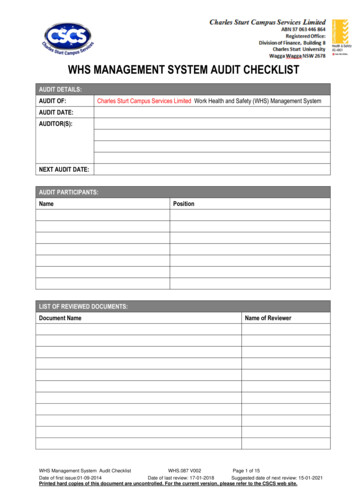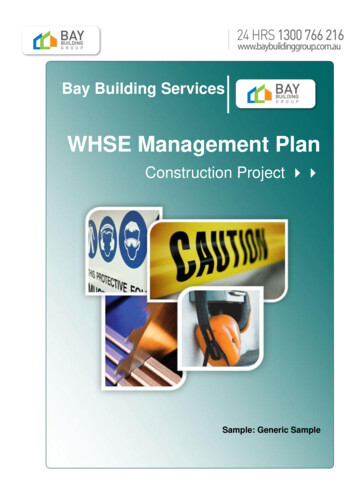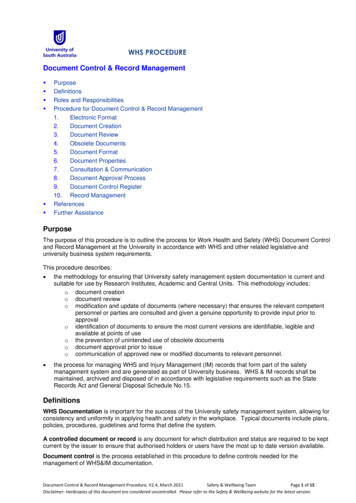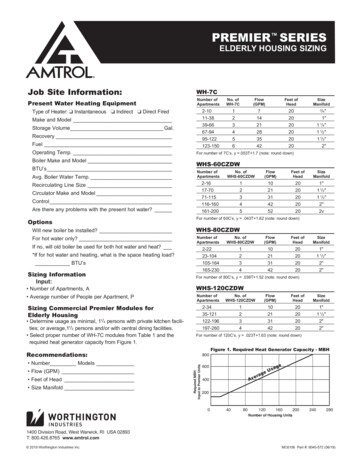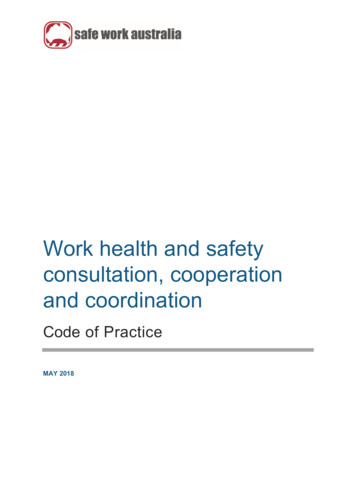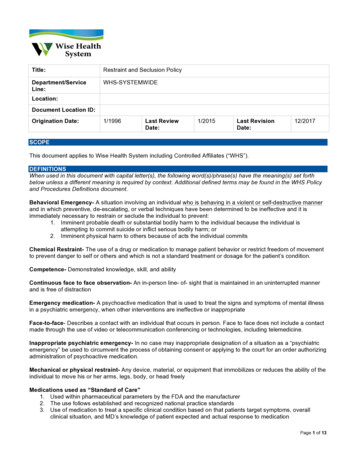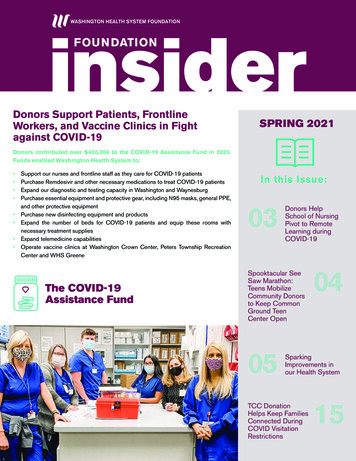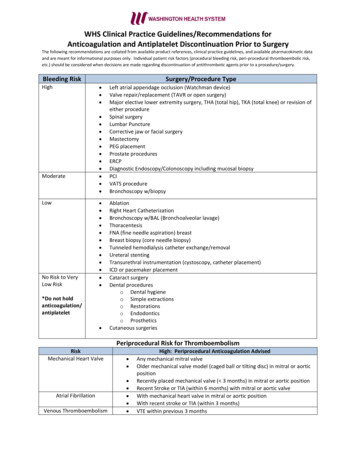
Transcription
WHS Clinical Practice Guidelines/Recommendations forAnticoagulation and Antiplatelet Discontinuation Prior to SurgeryThe following recommendations are collated from available product references, clinical practice guidelines, and available pharmacokinetic dataand are meant for informational purposes only. Individual patient risk factors (procedural bleeding risk, peri-procedural thromboembolic risk,etc.) should be considered when decisions are made regarding discontinuation of antithrombotic agents prior to a procedure/surgery.Bleeding RiskSurgery/Procedure Type HighModerateLowNo Risk to VeryLow Risk *Do not holdanticoagulation/antiplatelet Left atrial appendage occlusion (Watchman device)Valve repair/replacement (TAVR or open surgery)Major elective lower extremity surgery, THA (total hip), TKA (total knee) or revision ofeither procedureSpinal surgeryLumbar PunctureCorrective jaw or facial surgeryMastectomyPEG placementProstate proceduresERCPDiagnostic Endoscopy/Colonoscopy including mucosal biopsyPCIVATS procedureBronchoscopy w/biopsyAblationRight Heart CatheterizationBronchoscopy w/BAL (Bronchoalveolar lavage)ThoracentesisFNA (fine needle aspiration) breastBreast biopsy (core needle biopsy)Tunneled hemodialysis catheter exchange/removalUreteral stentingTransurethral instrumentation (cystoscopy, catheter placement)ICD or pacemaker placementCataract surgeryDental procedureso Dental hygieneo Simple extractionso Restorationso Endodonticso ProstheticsCutaneous surgeriesPeriprocedural Risk for ThromboembolismRiskMechanical Heart ValveAtrial FibrillationVenous Thromboembolism High: Periprocedural Anticoagulation AdvisedAny mechanical mitral valveOlder mechanical valve model (caged ball or tilting disc) in mitral or aorticpositionRecently placed mechanical valve ( 3 months) in mitral or aortic positionRecent Stroke or TIA (within 6 months) with mitral or aortic valveWith mechanical heart valve in mitral or aortic positionWith recent stroke or TIA (within 3 months)VTE within previous 3 months
Anticoagulant Discontinuation RecommendationsApixaban(Eliquis)Renal Function (Est CrCl) 30ml/min 30ml/min*Neuraxial procedure plannedApixaban Discontinuation PlanLow Bleeding RiskModerate-High Bleeding RiskStop 24 hours before surgicalStop 48 hours before surgicalprocedureprocedureStop 36-48 hours before surgicalStop 72 hours before surgicalprocedureprocedureHold 72 hours prior to procedureDabigatran (Pradaxa)Renal Function (Est CrCl) 50ml/min 50ml/min*Neuraxial procedure plannedDabigatran Discontinuation PlanLow Bleeding RiskModerate-High Bleeding RiskStop 24-36 hours before surgicalStop 48-72 hours before surgicalprocedureprocedureStop 48-72 hours before surgicalStop 96-120 hours before surgicalprocedureprocedureEst CrCl 80 ml/min 72 hrs before procedure50-79 ml/min 96 hrs before procedure30-49 ml/min 120 hrs before procedure 30ml/min Neuraxial procedure inappropriateRivaroxaban (Xarelto)Renal Function (Est CrCl) 30ml/min 30ml/min*Neuraxial procedure plannedRivaroxaban Discontinuation PlanLow Bleeding RiskModerate-High Bleeding RiskStop 24 hours before surgicalStop 48 hours before surgicalprocedureprocedureStop 48 hours before surgicalStop 72 hours before surgicalprocedureprocedureHold 72 hours prior to procedureEdoxaban (Savaysa)Renal Function (Est CrCl) 30ml/min 30ml/min*Neuraxial procedure plannedWarfarinEdoxaban Discontinuation PlanLow Bleeding RiskModerate-High Bleeding RiskStop 24 hours before surgicalStop 48 hours before surgicalprocedureprocedureStop 36 -48 hours before surgicalStop 72 hours before surgicalprocedureprocedureHold 72 hours prior to procedurePre-procedure INRPre-Procedure Plan2.0-3.0Stop 5 days before procedure3.0-4.5Stop 6 days before procedure 4.5Stop 6-7 days before procedureConsider rechecking INR after 2-3days of held dosesIf indicated consider phytonadioneEnoxaparin (Lovenox)In patients who are receiving bridgeLovenox Discontinuation PlanLast preoperative dose approximately 24 hours before surgeryLovenox Resumption24 hours in patients undergoing low-risk bleeding48-72 hours in patient undergoing high-bleeding risk surgeryIV Unfractionated Heparin (UFH)In patients who are receiving bridgeIV UFH Discontinuation Plan4-6 hours before surgery
Resuming Anticoagulation (VKA/Warfarin):WarfarinComplete hemostasisachieved, nocatastrophic bleedlocation (intracranial,intraspinal)NoYesConsider delayinginitiation ofanticoagulation; Useclinical judgementPlan to bridge?NoYesStart warfarin within24 hoursPost procedural bleedrisk?HighStart warfarin within24 hours, restartbridge within 48-72hoursJournal of the American College of Cardiology1LowRestart warfarin andbridge within 24 hours
Resuming Anticoagulation (DOAC):DOACComplete hemostasisachieved, no catastrophicbleed location(intracranial, intraspinal)YesNoConsider delayingreinitiation ofanticoagulation; useclinical judgementCan the patienttolerate oralmedications?YesNoPostprocedural bleedriskPostprocedural bleedriskHighReinitiate DOAC within48-72 hours followingprocedureLowReinitiate DOAC within24 hours. Considerreduced dose eveningfollowing procedureJournal of the American College of Cardiology1HighParenteralanticoagulation within48-72 hoursLowParenteralanticoagulation within24 hours
Noncardiac Surgery Recommendations for Patients on DualAntiplatelet Therapy for Percutaneous InterventionHemorrhagic RiskThrombotic RiskLow RiskIntermediateRiskHigh RiskLow RiskIntermediate RiskHigh RiskContinue ASA anddiscontinue P2Y12receptor inhibitor;resume within 24-72hoursContinue ASA anddiscontinue P2Y12receptor inhibitor;resume within 24-72hoursContinue ASA anddiscontinue P2Y12receptor inhibitor;resume within 24-72hoursContinue ASA anddiscontinue P2Y12receptor inhibitor;resume within 24-72hoursContinue ASA anddiscontinue P2Y12receptor inhibitor;resume within 24-72hoursContinue ASA;discontinue P2Y12receptor inhibitor;resume within 24–72hoursPostpone ElectiveSurgeryPostpone ElectiveSurgeryPostpone ElectiveSurgeryIf surgery cannot bedeferred, continue ASAand P2Y12 receptorinhibitorperioperatively.If surgerynondeferrable: continueASA; discontinue P2Y12receptor inhibitor;resume within 24–72hoursIf surgerynondeferrable: continueASA; discontinue P2Y12receptor inhibitor;resume within 24–72hoursAPT antiplatelet therapy; ASA aspirin; IV intravenous5.Banerjee, S., Angiolillo, D. J., Boden, W. E., Murphy, J. G., Khalili, H., Hasan, A. A., . . . Rao, S. V. (2017). Use of Antiplatelet Therapy/DAPT for PostPCI Patients Undergoing Noncardiac Surgery. Journal of the American College of Cardiology, 69(14), 1861-1870. doi:10.1016/j.jacc.2017.02.012**When indicated, recommendation is to hold P2Y12 inhibitors:Clopidogrel(Plavix): 5-7 days, Prasugrel(Effient): 7-10 days, Ticagrelor(Brillinta): 5-7 days, Ticlodipine(Ticlid):10 days
Determination of Thrombotic RiskLow Risk ( 1%)*Intermediate Risk(1-5%)*High Risk ( 5%)* 4 weeks after PCI withPOBA 2 weeks and / 4 weeksafter PCI with POBA / 2 weeks after PCI withPOBA 6 months after PCI withBMS 1 month and / 6 monthsafter PCI with BMS / 1 month after PCI withBMS 12 months after PCI withDES 6 months and / 12months after PCI with DES / 6 months after PCI withDES 12 months after complex / 12 months after complexPCI with DES (long stents,PCI with DESmultiple stents, overlapping,small vessels, bifurcations, / 6 months after PCI for MIleft main, last remainingvessel)Previous ST*30 day ischemic event rates of cardiovascular death and MIBMS bare metal stent(s), DES drug eluding sent(s), MI myocardial infarction, PCI percutaneouscoronary intervention, POBA plain old balloon angioplasty, ST stent thrombosis5.Banerjee, S., Angiolillo, D. J., Boden, W. E., Murphy, J. G., Khalili, H., Hasan, A. A., . . . Rao, S. V. (2017). Use of Antiplatelet Therapy/DAPT for PostPCI Patients Undergoing Noncardiac Surgery. Journal of the American College of Cardiology, 69(14), 1861-1870. doi:10.1016/j.jacc.2017.02.0121.Doherty, J. U., Gluckman, T. J., Hucker, W. J., Januzzi, J. L., Ortel, T. L., Saxonhouse, S. J., & Spinler, S. A. (2017). 2017 ACCExpert Consensus Decision Pathway for Periprocedural Management of Anticoagulation in Patients With Nonvalvular AtrialFibrillation. Journal of the American College of Cardiology, 69(7), 871-898. doi:10.1016/j.jacc.2016.11.0242.Douketis JD, Spyropoulos AC, Spencer FA, et al. Perioperative management of antithrombotic therapy: Antithrombotictherapy and prevention of thrombosis: American College of Chest Physicians Evidence-Based Clinical Practice Guidelines(9th Edition). CHEST. 2012;141:e326S-e350S.3.Wii DM, McCool KH, Dowd MB, et al. Incidence and predictors of bleeding or thrombosis after polypectomy in patientsreceiving and not receiving anticoagulation therapy. J Thromb Haemost. 2009;7(12):1982-9.4.Bahl V, Hu H, Henke P, et al. A validation study of a retrospective venous thromboembolism risk scoring method. Ann Surg.2010;251:344-350.5.Banerjee, S., Angiolillo, D. J., Boden, W. E., Murphy, J. G., Khalili, H., Hasan, A. A., . . . Rao, S. V. (2017). Use of AntiplateletTherapy/DAPT for Post-PCI Patients Undergoing Noncardiac Surgery. Journal of the American College of Cardiology, 69(14),1861-1870. doi:10.1016/j.jacc.2017.02.012Last updated 0520
Right Heart Catheterization Bronchoscopy w/BAL (Bronchoalveolar lavage) Thoracentesis FNA (fine needle aspiration) breast Breast biopsy (core needle biopsy) Tunneled hemodialysis catheter exchange/removal Ureteral stenting Transurethral instrumentation (cystoscopy, catheter placement)
